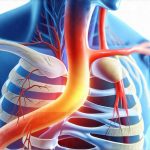Digestive discomfort – bloating, heartburn, constipation, even general feelings of sluggishness after eating – is an incredibly common experience. Many factors contribute to these issues, ranging from dietary choices and stress levels to underlying medical conditions. However, one often-overlooked factor impacting our digestion is surprisingly simple: posture. We rarely consider how the way we hold ourselves during and immediately following meals can significantly affect how efficiently our bodies process food. A seemingly minor adjustment in body position can make a world of difference, promoting healthy digestive function and reducing unpleasant symptoms. This article will explore the science behind this connection and provide practical strategies for optimizing your posture to ease digestion.
Our digestive system is not designed to operate optimally when compressed or constricted. Think of it as a series of interconnected tubes – the esophagus, stomach, small intestine, large intestine – that rely on gravity and muscular contractions (peristalsis) to move food along. When we slouch, hunch over, or lie down immediately after eating, we’re essentially creating obstacles for this natural process. This can lead to slower digestion, increased pressure in the abdomen, and a higher likelihood of acid reflux. Conversely, maintaining an upright posture allows gravity to assist with movement, reduces compression on digestive organs, and facilitates smoother peristalsis. It’s not about achieving perfect posture constantly, but rather being mindful of how your position impacts this vital bodily function. If you’re struggling with consistent discomfort, understanding how to naturally support gut transit can be a helpful starting point.
The Mechanics of Digestion & Posture’s Role
The process of digestion is complex, starting even before food enters our mouths with anticipation and salivary production. Once we begin eating, the stomach expands to accommodate the incoming food, mixing it with gastric juices to initiate breakdown. This partially digested food then moves into the small intestine, where most nutrient absorption takes place. Finally, undigested material passes into the large intestine for water absorption and eventual elimination. Each stage relies on proper positioning of the digestive organs. Slouching or compressing the abdomen directly impacts these stages.
- A slumped posture compresses the abdominal cavity, putting pressure on the stomach and intestines. This can slow down peristalsis – the wave-like muscular contractions that move food along the digestive tract – leading to bloating, constipation, and discomfort.
- Incorrect posture during eating can also increase the risk of acid reflux. When you’re hunched over, the lower esophageal sphincter (LES) – a valve preventing stomach acid from flowing back up into the esophagus – is more likely to remain open, allowing for heartburn and indigestion.
- The diaphragm, the primary muscle involved in breathing, plays a vital role in digestion. Poor posture restricts diaphragmatic movement, impacting abdominal massage during breathing which aids digestive function.
Essentially, optimal digestive function relies on space and uninhibited movement within the abdominal cavity. Proper posture provides that space, allowing our bodies to do what they’re naturally designed to do: efficiently process food and absorb nutrients. It’s about respecting the natural mechanics of your body and working with them rather than against them. When dealing with holiday-related issues, remember how to reduce digestive stress after indulgence.
Posture Practices During & After Meals
Improving your posture doesn’t require drastic changes; it’s about incorporating small, mindful adjustments into your daily routine. During meals, focus on sitting upright with good back support. Avoid leaning forward or hunching over your plate. Imagine a string pulling you up from the crown of your head – this encourages proper spinal alignment and opens up space in the abdominal cavity. Consider using a chair that promotes good posture, or adding lumbar support if needed.
After eating, resist the urge to immediately recline or lie down. Instead, maintain an upright position for at least 20-30 minutes. This allows gravity to aid digestion and reduces the risk of acid reflux. Gentle walking after meals is also highly beneficial, as it stimulates peristalsis and promotes efficient movement of food through the digestive tract. Avoid strenuous exercise immediately following a meal, as this can divert blood flow away from the digestive system. Think of active recovery – gentle movements that support, rather than challenge, digestion. If you often experience discomfort after heavy meals, exploring how to ease digestive symptoms can be beneficial.
Optimizing Your Sitting Posture for Digestion
Sitting posture is often the biggest culprit when it comes to digestive discomfort. Many of us spend hours each day seated, making mindful adjustments crucial. Here’s how to refine your sitting habits:
– Feet flat on the floor: This provides a stable base and prevents unnecessary strain on the lower back. If your feet don’t reach, use a footrest.
– Back supported: Ensure your chair offers adequate lumbar support, or use a cushion if needed. Avoid slouching; maintain a natural curve in your lower back.
– Shoulders relaxed: Keep your shoulders down and relaxed, avoiding tension that can restrict breathing and digestive function.
– Elbows close to the body: This reduces strain on the upper back and promotes good posture.
Regularly assessing your sitting posture throughout the day is key. Set reminders on your phone or use a posture correcting app if needed. Even small adjustments – straightening your back, adjusting your chair height, or shifting your weight – can make a significant difference. The goal isn’t perfection but consistent awareness and mindful correction. Sometimes comfort meals to ease tension are also helpful in managing these symptoms.
Gentle Movements to Support Digestion
Beyond postural alignment, incorporating gentle movements after meals can further enhance digestive function. These movements don’t need to be intense; the focus is on stimulating peristalsis and relieving tension.
– Walking: A 10-20 minute walk after eating is one of the most effective ways to aid digestion. It encourages movement in the intestines, reducing bloating and constipation.
– Diaphragmatic Breathing: Practice deep, slow breaths that engage your diaphragm. This stimulates abdominal massage, promoting digestive function. Place a hand on your abdomen while breathing to feel the rise and fall.
– Gentle Stretching: Simple stretches like torso twists or side bends can help release tension in the abdomen and improve circulation.
These movements should be comfortable and enjoyable. Avoid any exercise that causes pain or discomfort. Remember, the goal is to support your digestive system, not to push it beyond its limits. Prioritizing mindful movement – listening to your body and adjusting accordingly – will yield the best results.
Addressing Specific Digestive Concerns With Posture
Different digestive issues may respond differently to specific postural adjustments. For example:
– Acid Reflux: Elevating the upper body while sleeping can help prevent stomach acid from flowing back up into the esophagus. Use pillows or adjust your bed frame to create a slight incline. Also, avoid lying down immediately after eating and maintain an upright posture during meals.
– Bloating: Gentle movements like walking or yoga poses that involve twisting can help release trapped gas and relieve bloating. Avoid tight clothing that constricts the abdomen.
– Constipation: Staying hydrated, incorporating fiber into your diet, and maintaining an upright posture are all crucial for combating constipation. Regular walking also stimulates intestinal movement.
It’s important to remember that postural adjustments are just one piece of the puzzle when it comes to managing digestive health. A holistic approach – encompassing a balanced diet, stress management techniques, and regular exercise – is essential. If you’re experiencing persistent or severe digestive discomfort, consult with a healthcare professional to rule out any underlying medical conditions. Understanding digestive discomfort after high-fat meals can also help inform your dietary choices and lifestyle adjustments. Finally, if your digestive issues are impacting your daily life, remember how to navigate employment during treatment or recovery.


















